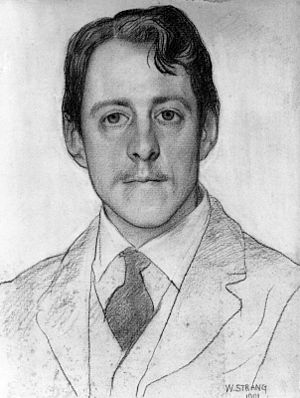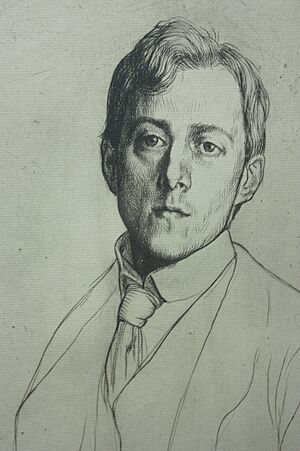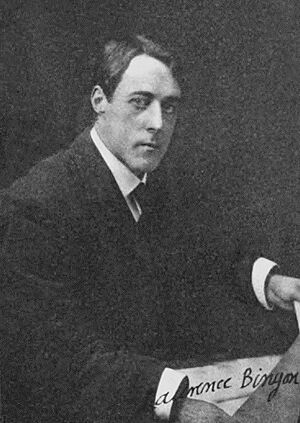Laurence Binyon facts for kids
Quick facts for kids
Laurence Binyon
|
|
|---|---|

Drawing of Laurence Binyon by William Strang, 1901
|
|
| Born | Robert Laurence Binyon 10 August 1869 Lancaster, Lancashire, England |
| Died | 10 March 1943 (aged 73) Reading, Berkshire, England |
| Occupation | Poet, dramatist, scholar |
| Spouse | Cicely Margaret Powell |
| Children | Helen Binyon Margaret Binyon Nicolete Gray |
| Relatives | T. J. Binyon (great-nephew) Camilla Gray (granddaughter) |

Laurence Binyon (born August 10, 1869 – died March 10, 1943) was an English poet, writer, and art expert. He was born in Lancaster, England. His father, Frederick Binyon, was a clergyman, and his mother was Mary Dockray.
He went to St Paul's School, London and then Trinity College, Oxford. At Oxford, he won a special award for poetry in 1891 called the Newdigate Prize. From 1893 until 1933, he worked at the famous British Museum.
In 1904, he married Cicely Margaret Powell, who was a historian. They had three daughters, including the artist Nicolete Gray.
Laurence Binyon is best known for his poem "For the Fallen". He wrote it in 1914 after many soldiers were hurt in World War I. This poem is often read during Remembrance Sunday services in the UK, Australia, New Zealand, and Canada.
In 1915, even though he was older, Binyon volunteered to help wounded soldiers in France. He later worked in England, caring for those injured in the Battle of Verdun. He wrote about these experiences in his book For Dauntless France. After the war, he kept working at the British Museum and wrote many books about art.
Early Life and Work
Laurence Binyon grew up in Lancaster, England. His father was a clergyman, and his mother's father was a main engineer for a railway. His family had a Quaker background.
After studying at St Paul's School, London, Binyon went to Trinity College, Oxford. He studied ancient Greek and Roman literature. In 1891, he won the Newdigate Prize for his poetry.
Right after college in 1893, Binyon started working at the British Museum. He wrote guides for the museum and books about art. In 1895, his first book, Dutch Etchers of the Seventeenth Century, was published.
He later moved to the museum's Department of Prints and Drawings. He became an Assistant Keeper in 1909. In 1913, he became the Keeper of the new Oriental Prints and Drawings section. He helped introduce young poets like Ezra Pound to East Asian art and literature. Many of Binyon's books were about art, including detailed guides to Chinese and Japanese prints.
In 1904, he married Cicely Margaret Powell. They had three daughters. Binyon was part of a group of artists and thinkers in London. They often met at the Vienna Café. This group included famous artists like William Rothenstein and Edmund Dulac.
Before World War I, Binyon was a well-known poet. Some people even thought he might become the next Poet Laureate in 1913.
"For the Fallen" Poem
In 1914, World War I had just started, and many soldiers were already getting hurt. This moved Binyon to write his famous poem "For the Fallen". He wrote it while visiting the cliffs in Cornwall, England.
The poem was published in The Times newspaper in September 1914. This was when people were feeling sad about the recent Battle of the Marne.
Today, "For the Fallen" is Binyon's most famous poem. It is often read at Remembrance Sunday services in the UK. It is also a key part of Anzac Day services in Australia and New Zealand. In Canada, it is read on November 11th for Remembrance Day. The part of the poem called the "Ode of Remembrance" is seen as a tribute to all soldiers lost in war.
Here are some lines from the poem:
- They went with songs to the battle, they were young.
- Straight of limb, true of eyes, steady and aglow.
- They were staunch to the end against odds uncounted,
- They fell with their faces to the foe.
- They shall grow not old, as we that are left grow old:
- Age shall not weary them, nor the years condemn.
- At the going down of the sun and in the morning,
- We will remember them.
- They mingle not with their laughing comrades again;
- They sit no more at familiar tables of home;
- They have no lot in our labour of the day-time;
- They sleep beyond England's foam
The "Ode to Remembrance" is the middle part of the seven-stanza poem "For the Fallen". The full poem can be found online.
Three of Binyon's poems, including "For the Fallen", were used in a musical work by Sir Edward Elgar. It was called The Spirit of England.
In 1915, Binyon was too old to join the army. But he still volunteered at a British hospital in France. He worked as an orderly, helping French soldiers. He returned in 1916 and cared for soldiers from the Battle of Verdun. He wrote about these experiences in his book For Dauntless France (1918). His poems "Fetching the Wounded" and "The Distant Guns" were inspired by his hospital work.
You can even hear Binyon himself reading "For the Fallen". His voice is on an old recording from Japan. This recording is part of an audiobook called Artists Rifles, released in 2004.
Later Life and Works
After World War I, Binyon went back to the British Museum. He wrote many books about art, especially about William Blake, Persian art, and Japanese art. His work on ancient Japanese and Chinese cultures inspired poets like Ezra Pound and W. B. Yeats.
In 1931, his collected poems were published in two books. In 1932, Binyon became the Keeper of the Prints and Drawings Department. He retired from the British Museum in 1933. He moved to the countryside, where he continued to write poetry.
From 1933 to 1934, Binyon was a special professor at Harvard University in the United States. He gave talks about "The Spirit of Man in Asian Art." In 1940, he became a professor at the University of Athens in Greece. He had to leave quickly in 1941 to escape the German invasion.
Binyon was friends with the poet Ezra Pound. Pound even helped Binyon with his translation of Dante's famous poem, Divine Comedy. Binyon spent twenty years translating Dante's work. He finished it just before he died.
During World War II, Binyon kept writing poems. One long poem about the London Blitz (bombing of London) was called "The Burning of the Leaves." Many people think this poem is his best work.
Laurence Binyon died on March 10, 1943, at the age of 73. He was working on a big three-part story about King Arthur when he passed away. The first part was published after his death.
His ashes were scattered in a churchyard in Aldworth, Berkshire. On November 11, 1985, Binyon was honored at Westminster Abbey's Poets' Corner. A stone was placed there to remember him and 15 other World War I poets.
Family Life
Laurence Binyon had three daughters: Helen, Margaret, and Nicolete. All of them became artists.
Helen Binyon (1904–1979) studied art and illustrated many books. She was also a puppeteer and wrote books about puppetry. Margaret Binyon wrote children's books, which Helen illustrated. Nicolete, known as Nicolete Gray, became a well-known expert in calligraphy (beautiful handwriting) and art.



